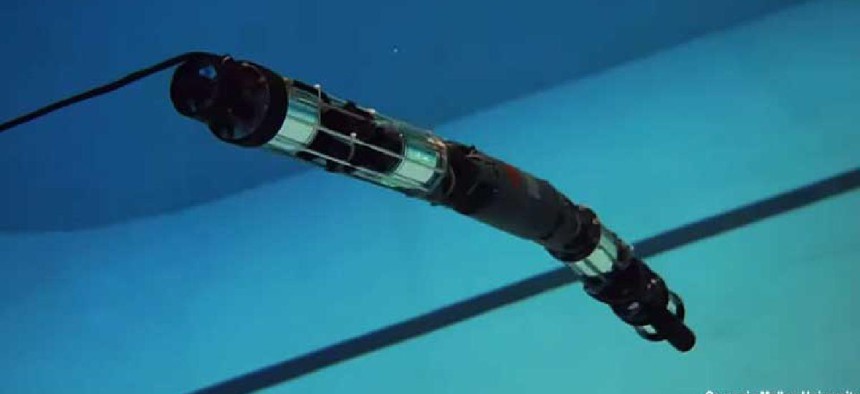‘Snakebot’ takes a dive to go where other robots can’t

The submersible robot snake project aims to assist the Navy with inspecting ships, submarines, and other underwater infrastructure for damage or as part of routine maintenance.
A snake-like robot can now slither its way through water, allowing it to inspect ships, submarines, and underwater infrastructure for damage.
Researchers from the Biorobotics Lab in the School of Computer Science’s Robotics Institute at Carnegie Mellon University tested the hardened underwater modular robot snake (HUMRS) last month in the pool, diving the robot through underwater hoops, showing off its precise and smooth swimming, and demonstrating its ease of control.
“We can go places that other robots cannot,” says Howie Choset, professor of computer science. “It can snake around and squeeze into hard-to-reach underwater spaces.” Choset and Matt Travers, co-directors of the Biorobotics Lab, led the work.
The submersible robot snake project aims to assist the Department of Defense with inspecting ships, submarines, and other underwater infrastructure for damage or as part of routine maintenance, says Matt Fischer, the program manager at the Advanced Robotics for Manufacturing (ARM) Institute.
Snakebot could save time and money
The military has limited options for inspecting areas like a ship’s hull. To do so, the Navy must either send a team of divers to the ship’s location, wait until it returns to port to deploy the divers, or pull it into a dry dock -- all options that take time and money.
A submersible robot snake could allow the Navy to inspect the ship at sea, immediately alerting the crew to critical damage or sending information about issues that need attention back to port for use when the ship docks.
“If they can get that information before the ship comes into a home port or a dry dock, that saves weeks or months of time in a maintenance schedule,” says Fischer, who served in the Navy for three years. “And in turn, that saves money.”
Fischer, who crawled into the ballast tanks of a submarine during his service, says many sailors would gladly pass that difficult and tight duty to a robot.
Steve McKee, a co-lead of the Joint Robotics Organization for Building Organic Technologies (JROBOT), a Department of Defense task force interested in technology like the submersible robot snake, says the project will improve the readiness of equipment in the armed services.
“The advancements being made hold great promise for helping not only the Department of Defense but also various industries around the world,” McKee says.
Snake in the pool!
Outside the military, the robots could inspect underwater pipes for damage or blockages, assess offshore oil rigs, or check the integrity of a tank while it is filled with liquid. The robot could be used to inspect and maintain any fluid-filled systems, says Nate Shoemaker-Trejo, a mechanical and mechatronics engineer in the Biorobotics Lab working on the submersible snakebot.
“The distinguishing feature is the robot’s form factor and flexibility. The smallest versions of regular submersibles are usually blocky, one-piece arrangements. The robot snake is narrow and jointed,” Shoemaker-Trejo says. “The end result is that an underwater robot snake can squeeze around corners and into small spaces where regular submersibles can’t go.”
Versions of the robot snakes have already proven useful in difficult situations. Travers led a team to Mexico City in 2017 to use robot snakes in a search-and-rescue mission after an earthquake. And a robot snake made a lasting impression on Jimmy Fallon when it climbed up his leg as a guest on NBC’s The Tonight Show with Jimmy Fallon.
The robot’s modular design allows it to adapt to different tasks, whether squeezing through tight spaces under rubble, climbing up a tree, or slithering around a corner underwater. For the underwater robot snake, the team used existing watertight modules that allow the robot to operate in bad conditions. They then added new modules containing the turbines and thrusters needed to maneuver the robot underwater.
Development progressed rapidly. The team started working on the underwater robot snake in July 2020 and by March 2021, had it swimming in the pool.
“I’m surprised that we made this robot work as fast as we did,” Choset says.
A grant from the Advanced Robotics for Manufacturing Institute funded the work.
This article was posted from Futurity.





